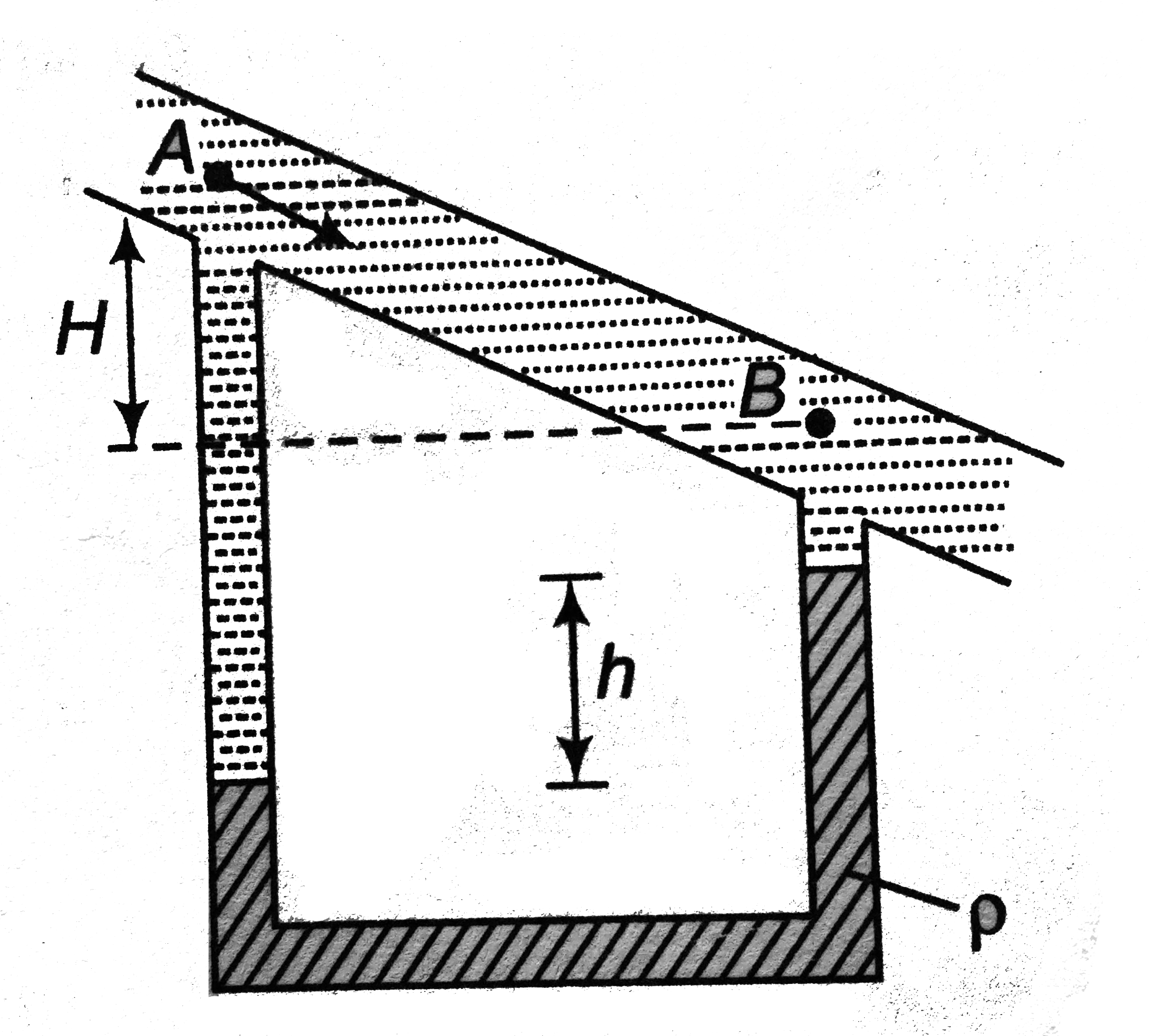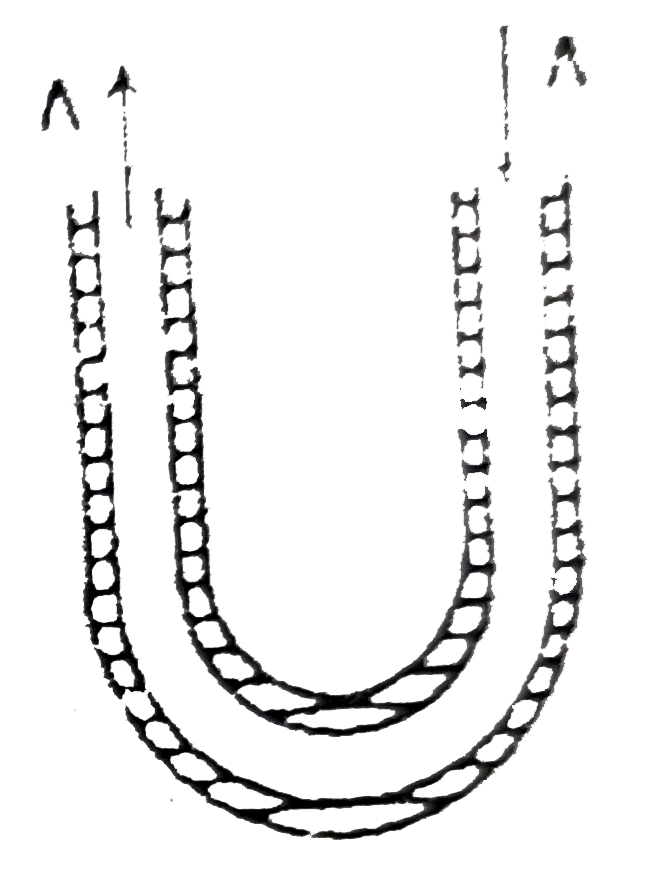In a horizontal pipeline of uniform cross section the pressure falls by 8N/m2 between two points separated by 1km. If oil of density 800kg/m3 flows through the pipe, find the change in KE per kg of oil at these points.
10−2J/kg
10−3J/kg
10−4J/kg
10−1J/kg
The correct Answer is:A
To solve the problem, we will use Bernoulli's principle, which relates the pressure, velocity, and height of a fluid flowing in a horizontal pipe. Let's break down the steps:
Step 1: Understand the given data
- Pressure drop (ΔP) = 8 N/m²
- Density of oil (ρ) = 800 kg/m³
- Distance between the two points (L) = 1 km = 1000 m
Step 2: Apply Bernoulli's equation
For a horizontal pipe, Bernoulli's equation can be simplified to:
P1+12ρV21=P2+12ρV22
Rearranging this gives us:
P1−P2=12ρV22−12ρV21
Step 3: Express the change in kinetic energy per unit mass
The change in kinetic energy per unit mass (ΔKE) can be expressed as:
ΔKE=12ρV22−12ρV21=P1−P2ρ
Step 4: Substitute the known values
We know:
- P1−P2=8N/m2
- ρ=800kg/m3
Substituting these values into the equation gives:
ΔKE=8800
Step 5: Calculate ΔKE
Now, perform the calculation:
ΔKE=8800=0.01J/kg
Final Answer
The change in kinetic energy per kg of oil at these points is:
ΔKE=0.01J/kg
---
- Pressure drop (ΔP) = 8 N/m²
- Density of oil (ρ) = 800 kg/m³
- Distance between the two points (L) = 1 km = 1000 m
For a horizontal pipe, Bernoulli's equation can be simplified to:
P1+12ρV21=P2+12ρV22
P1−P2=12ρV22−12ρV21
The change in kinetic energy per unit mass (ΔKE) can be expressed as:
ΔKE=12ρV22−12ρV21=P1−P2ρ
We know:
- P1−P2=8N/m2
- ρ=800kg/m3
ΔKE=8800
Now, perform the calculation:
ΔKE=8800=0.01J/kg
The change in kinetic energy per kg of oil at these points is:
ΔKE=0.01J/kg
Topper's Solved these Questions
- FLUID MECHANICSBOOK - CENGAGE PHYSICS ENGLISHCHAPTER - FLUID MECHANICSEXERCISE - Multipe Correct
15 Videos
- FLUID MECHANICSBOOK - CENGAGE PHYSICS ENGLISHCHAPTER - FLUID MECHANICSEXERCISE - Assertion-Reasoning
8 Videos
- FLUID MECHANICSBOOK - CENGAGE PHYSICS ENGLISHCHAPTER - FLUID MECHANICSEXERCISE - Subjective
25 Videos
- DIMENSIONS & MEASUREMENTBOOK - CENGAGE PHYSICS ENGLISHCHAPTER - DIMENSIONS & MEASUREMENTEXERCISE - Integer
2 Videos
- GRAVITATIONBOOK - CENGAGE PHYSICS ENGLISHCHAPTER - GRAVITATIONEXERCISE - INTEGER_TYPE
1 Videos
Similar Questions
The pressure inside a soap bubble of radius 1 cm balances a 1.5 mm column of oil of density 800 kgm−3. Find the surface tension of the soap solution.
View SolutionThe figure shown a pipe of uniform cross-section inclined in a vertical plane. A U-tube manometer is connected between the point A and B. If the liquid of density ρ0 flows with velocity v0 in the pipe. Then the reading h of the manometer is

View SolutionIt water flows horizontally through a pipe of varying cross section and the pressure of water equals 10cm of g at a point where the velocity of flow is 40cm/s, what is the pressure at another point where the velocity of flow is 50cm/s?
View SolutionWater flows steadily through a horizontal pipe of variable cross-section. If the pressure of water is p at a point where the velocity of flow is v, at another point (pressure p'), where the velocity of flow in ηv : The following statements are given below
View SolutionWater is flowing steadily through a horizontal pipe of non - uniform cross - section . If the velocity of water cross - section is 0.02m2 is 2m/s , what is the velocity of water at another point where the cross - section is 0.01m2 ?
View SolutionWater flows steadily through a horizontal pipe of a variable cross-section. If the pressure of the water is p at a point , where the speed of the flow is v. What is the pressure at another point , where the speed of the flow is 2 v ? Let the density of water be 1gcm−3.
View SolutionA pipe of circular cross-section of inner radius r and outer radius 2r is bent into a semi circle as shown in the diagram. A fluid of density ρ=103kg/m3 is flowing through it. The breaking stress of the material of the pipe is 3×107n/m2. The maximum velocity with which the fluid can flow in the pipe is k×100m/s. find value of k.

View Solution_S01_015_Q01.png)
A vertical U-tube of uniform cross-section contains mercury in both arms A glycerine (relative density =1.3) column of length 10 cm is introduced into one of the arms. Oil of density 800 gm m−3 is poured into the other arm until the upper surface of the oil and hlycerine are at the same horizontal level, find the length of the column. Density of mercury is 13.6×103kgm−3
View SolutionWater flows through a horizontal tube of variable cross section.The area of cross section at A and B are 4 mm2and2mm2 respectively. If 1 cc of water enters per second through A find
a) The speed of water at A
b) the speed of river at B
c) the pressure difference PA−PB.

View SolutionWater flows through a horizontal pipe of varying area of cross section at the rate 15 cubic metre per minute. Find the radius of pipe where water velocity is 3 ms−1
View Solution
